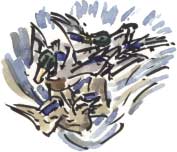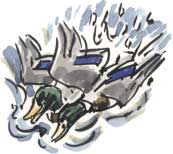
|
Rapid ReactionSaturday, 12th April 2003, West Yorkshire |
![]()
![]()
![]()
![]() Rocks | History |
Workshop |
Links | Home
Page
Rocks | History |
Workshop |
Links | Home
Page
![]()
 There's
a scrap going on at the foot of the weir. It looks as if two drake mallards
are attacking a duck. I saw this happen years ago in St James Park, London.
A hapless duck was being pursued by at least half a dozen drakes along
the lake. She couldn't get away and eventually her attackers drowned her.
Her bedraggled body floated along the surface.
There's
a scrap going on at the foot of the weir. It looks as if two drake mallards
are attacking a duck. I saw this happen years ago in St James Park, London.
A hapless duck was being pursued by at least half a dozen drakes along
the lake. She couldn't get away and eventually her attackers drowned her.
Her bedraggled body floated along the surface.
 We're
concerned to see the outcome but from up on the bridge there's nothing
that we can do to intervene. The female disappears without a trace in
the rapids while the drakes battle it out, one trying to force the other
underwater with his wing.
We're
concerned to see the outcome but from up on the bridge there's nothing
that we can do to intervene. The female disappears without a trace in
the rapids while the drakes battle it out, one trying to force the other
underwater with his wing.
 After
a minute or two the loser struggles free and flies off, with the other
drake soon in hot pursuit.
After
a minute or two the loser struggles free and flies off, with the other
drake soon in hot pursuit.
We scan with binoculars around the rocks, rapids and shoreline. We can't find any sign of the duck. After a pause that was just too long for you to think she'd survived, she's suddenly there again, below us, swimming up from the bridge arches, sitting low in the water, looking wet and bedraggled but apparently unharmed.
 Soon
one of the drakes flies back upstream and settles on the water beside
her. I realise, by the way the duck seems at ease, that this must be her
mate. He needs to be on continual guard: soon the interloper reappears,
arcs down towards them, lands on the water nearby and the drake has to
chase him off again. I wonder what will be the outcome of this canarderie
a trois.
Soon
one of the drakes flies back upstream and settles on the water beside
her. I realise, by the way the duck seems at ease, that this must be her
mate. He needs to be on continual guard: soon the interloper reappears,
arcs down towards them, lands on the water nearby and the drake has to
chase him off again. I wonder what will be the outcome of this canarderie
a trois.
Decoy Ducks
 I
always think of a domestic love triangle as being a ménagerie
à trois: this shows how poor my French is; that would translate
as a very small zoo. The correct expression is ménage à
trois (eternal triangle, or literally a 'household of three').
I
always think of a domestic love triangle as being a ménagerie
à trois: this shows how poor my French is; that would translate
as a very small zoo. The correct expression is ménage à
trois (eternal triangle, or literally a 'household of three').
But there is such a word as canarderie; it's what we would call a duck decoy - a netting tunnel that funnels wildfowl down a channel from a lake into the trap. Sometimes a small dog is trained to decoy the wildfowl. Ducks and geese prefer to have predators in full view so they're tempted to see what is going on when they get glimpses of the dog running in and out from behind screens alongside the tunnel.
This picture comes from a French website that is so plagued by pop-up adverts that it is almost impossible to view, otherwise I'd give you the URL. Just visible is a dog (on the path by the entrance to the trap?) and also, apparently, the head of the carnardier, or wildfowler,who is looking out from behind a reed screen to supervise the work.
According to the text the wildfowler also has ducks which he's trained to lure the wild birds into the trap. The article points out that these ducks 'actually play the role of traitors and of provocative agents'.
While canard means 'duck' in French canarder means 'to snipe at (with a rifle) or pelt with stones'. Our English 'ducks and drakes' refers to the pastime of skimming a stone across a pond or lake.
Here's a quote that came to mind as I was writing that:
'Decoy duck doth clatter and quack'
I've no idea where it comes from, or if I've quoted it correctly. Any
ideas please?
![]()
![]() Next page | Previous
page | This day in 2000
| This month | Nature
Diary | Home
Page
Next page | Previous
page | This day in 2000
| This month | Nature
Diary | Home
Page
![]()